School of Science ENGIN3201: Timber Floor System Design Project
VerifiedAdded on 2022/08/31
|13
|1645
|16
Project
AI Summary
This assignment presents the design of a timber floor system for a proposed theatre restaurant within an existing building. The project encompasses several key areas, including the architectural layout of the building, which must be drawn to scale and accompanied by a design memorandum explaining the rationale behind the chosen layout. The design also involves detailed calculations for the mezzanine floor, specifically focusing on the bearers and joists required to support the structure. Furthermore, the assignment requires the design of the supporting columns for the mezzanine floor, ensuring structural integrity. The solution also includes the design of stairs and incorporates relevant figures and diagrams to illustrate the design components. The project emphasizes the use of exposed timber for both structural and aesthetic purposes, aligning with the building's renovation goals. The solution also references relevant Australian Standards (AS 1684, AS 4055, AS 1170.2) and considers wind loads and building height limitations. The project's conclusion highlights the versatility and advantages of using wood as a construction material, particularly in earthquake-resistant structures, while acknowledging its limitations and the importance of proper construction techniques.

Paraphrase This Document
Need a fresh take? Get an instant paraphrase of this document with our AI Paraphraser
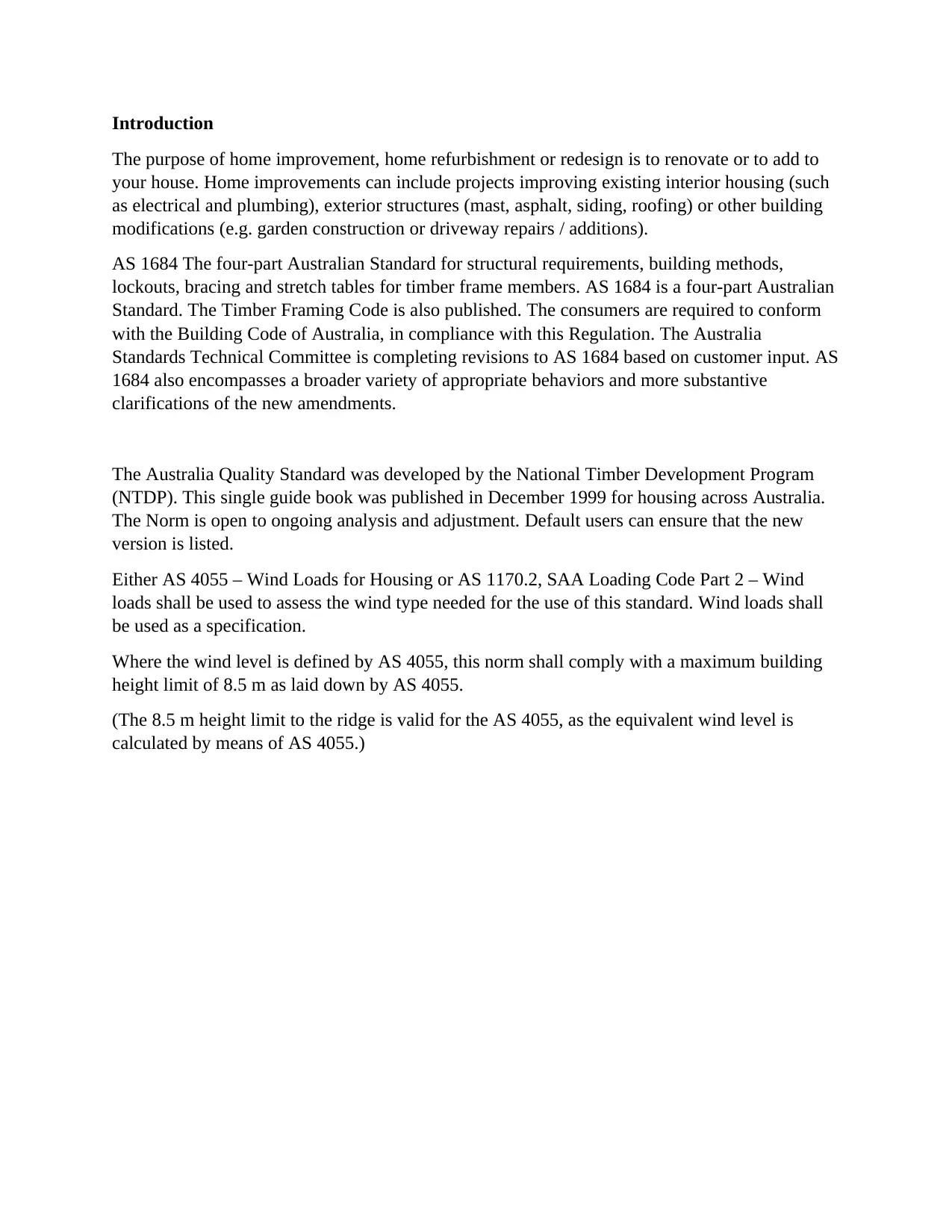
Introduction
The purpose of home improvement, home refurbishment or redesign is to renovate or to add to
your house. Home improvements can include projects improving existing interior housing (such
as electrical and plumbing), exterior structures (mast, asphalt, siding, roofing) or other building
modifications (e.g. garden construction or driveway repairs / additions).
AS 1684 The four-part Australian Standard for structural requirements, building methods,
lockouts, bracing and stretch tables for timber frame members. AS 1684 is a four-part Australian
Standard. The Timber Framing Code is also published. The consumers are required to conform
with the Building Code of Australia, in compliance with this Regulation. The Australia
Standards Technical Committee is completing revisions to AS 1684 based on customer input. AS
1684 also encompasses a broader variety of appropriate behaviors and more substantive
clarifications of the new amendments.
The Australia Quality Standard was developed by the National Timber Development Program
(NTDP). This single guide book was published in December 1999 for housing across Australia.
The Norm is open to ongoing analysis and adjustment. Default users can ensure that the new
version is listed.
Either AS 4055 – Wind Loads for Housing or AS 1170.2, SAA Loading Code Part 2 – Wind
loads shall be used to assess the wind type needed for the use of this standard. Wind loads shall
be used as a specification.
Where the wind level is defined by AS 4055, this norm shall comply with a maximum building
height limit of 8.5 m as laid down by AS 4055.
(The 8.5 m height limit to the ridge is valid for the AS 4055, as the equivalent wind level is
calculated by means of AS 4055.)
The purpose of home improvement, home refurbishment or redesign is to renovate or to add to
your house. Home improvements can include projects improving existing interior housing (such
as electrical and plumbing), exterior structures (mast, asphalt, siding, roofing) or other building
modifications (e.g. garden construction or driveway repairs / additions).
AS 1684 The four-part Australian Standard for structural requirements, building methods,
lockouts, bracing and stretch tables for timber frame members. AS 1684 is a four-part Australian
Standard. The Timber Framing Code is also published. The consumers are required to conform
with the Building Code of Australia, in compliance with this Regulation. The Australia
Standards Technical Committee is completing revisions to AS 1684 based on customer input. AS
1684 also encompasses a broader variety of appropriate behaviors and more substantive
clarifications of the new amendments.
The Australia Quality Standard was developed by the National Timber Development Program
(NTDP). This single guide book was published in December 1999 for housing across Australia.
The Norm is open to ongoing analysis and adjustment. Default users can ensure that the new
version is listed.
Either AS 4055 – Wind Loads for Housing or AS 1170.2, SAA Loading Code Part 2 – Wind
loads shall be used to assess the wind type needed for the use of this standard. Wind loads shall
be used as a specification.
Where the wind level is defined by AS 4055, this norm shall comply with a maximum building
height limit of 8.5 m as laid down by AS 4055.
(The 8.5 m height limit to the ridge is valid for the AS 4055, as the equivalent wind level is
calculated by means of AS 4055.)
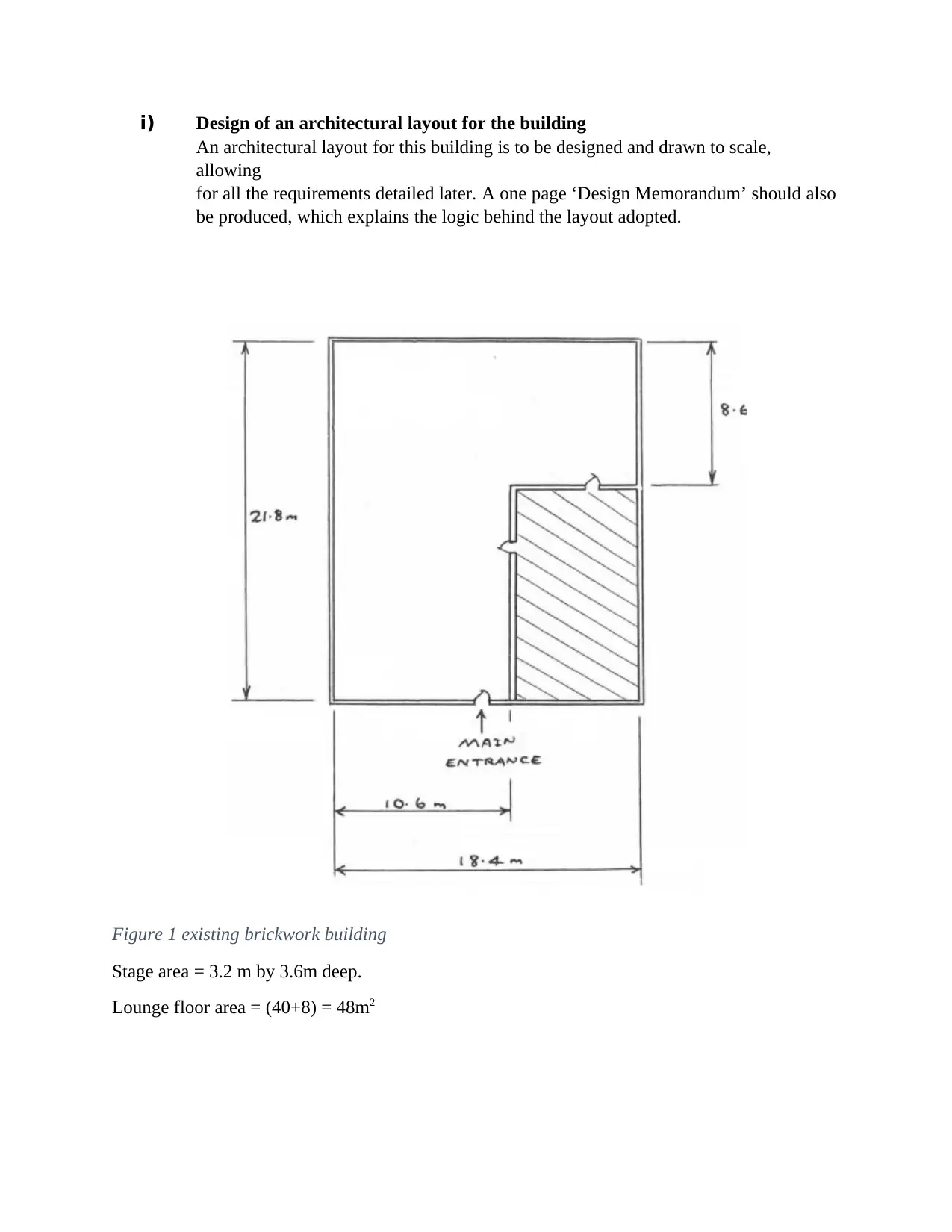
i) Design of an architectural layout for the building
An architectural layout for this building is to be designed and drawn to scale,
allowing
for all the requirements detailed later. A one page ‘Design Memorandum’ should also
be produced, which explains the logic behind the layout adopted.
Figure 1 existing brickwork building
Stage area = 3.2 m by 3.6m deep.
Lounge floor area = (40+8) = 48m2
An architectural layout for this building is to be designed and drawn to scale,
allowing
for all the requirements detailed later. A one page ‘Design Memorandum’ should also
be produced, which explains the logic behind the layout adopted.
Figure 1 existing brickwork building
Stage area = 3.2 m by 3.6m deep.
Lounge floor area = (40+8) = 48m2
⊘ This is a preview!⊘
Do you want full access?
Subscribe today to unlock all pages.

Trusted by 1+ million students worldwide
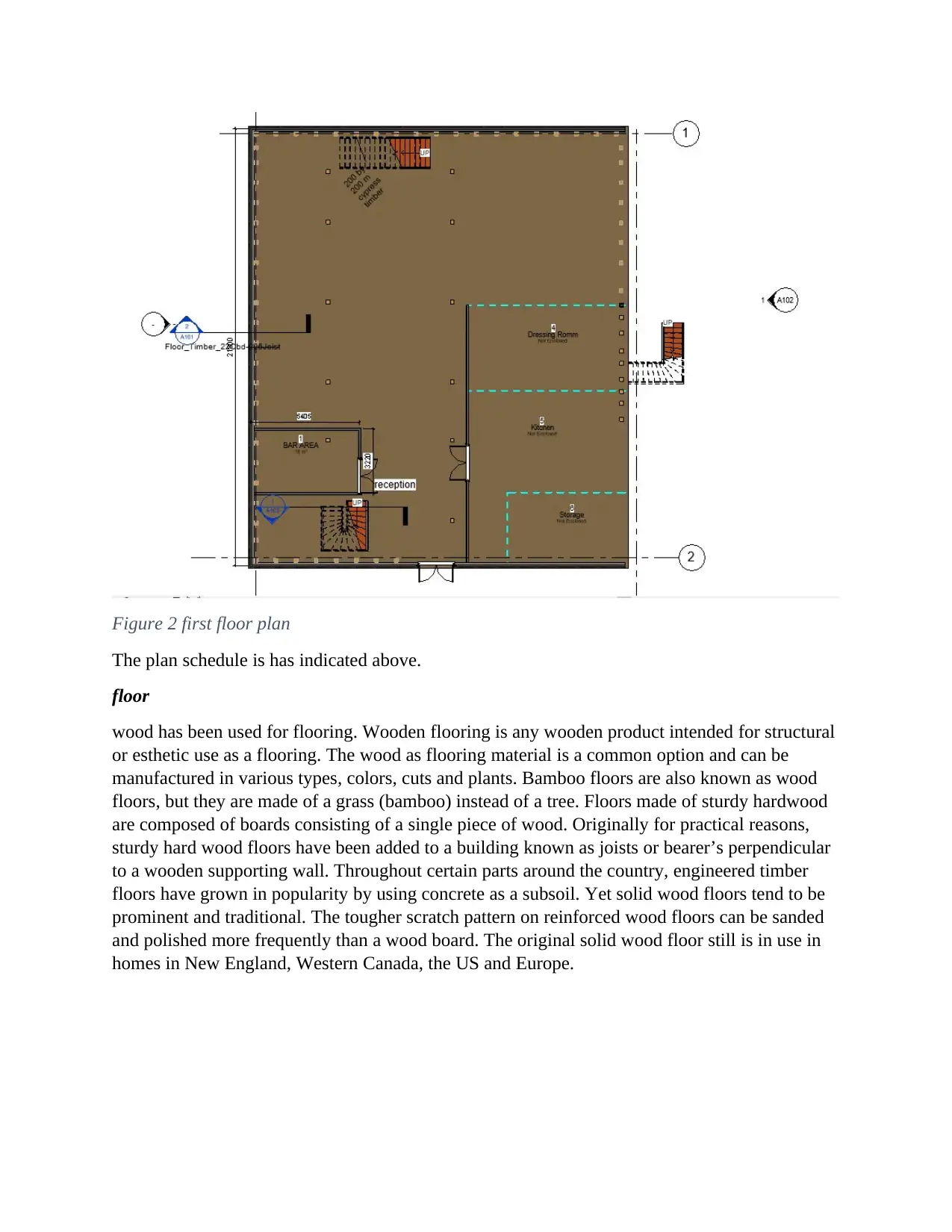
Figure 2 first floor plan
The plan schedule is has indicated above.
floor
wood has been used for flooring. Wooden flooring is any wooden product intended for structural
or esthetic use as a flooring. The wood as flooring material is a common option and can be
manufactured in various types, colors, cuts and plants. Bamboo floors are also known as wood
floors, but they are made of a grass (bamboo) instead of a tree. Floors made of sturdy hardwood
are composed of boards consisting of a single piece of wood. Originally for practical reasons,
sturdy hard wood floors have been added to a building known as joists or bearer’s perpendicular
to a wooden supporting wall. Throughout certain parts around the country, engineered timber
floors have grown in popularity by using concrete as a subsoil. Yet solid wood floors tend to be
prominent and traditional. The tougher scratch pattern on reinforced wood floors can be sanded
and polished more frequently than a wood board. The original solid wood floor still is in use in
homes in New England, Western Canada, the US and Europe.
The plan schedule is has indicated above.
floor
wood has been used for flooring. Wooden flooring is any wooden product intended for structural
or esthetic use as a flooring. The wood as flooring material is a common option and can be
manufactured in various types, colors, cuts and plants. Bamboo floors are also known as wood
floors, but they are made of a grass (bamboo) instead of a tree. Floors made of sturdy hardwood
are composed of boards consisting of a single piece of wood. Originally for practical reasons,
sturdy hard wood floors have been added to a building known as joists or bearer’s perpendicular
to a wooden supporting wall. Throughout certain parts around the country, engineered timber
floors have grown in popularity by using concrete as a subsoil. Yet solid wood floors tend to be
prominent and traditional. The tougher scratch pattern on reinforced wood floors can be sanded
and polished more frequently than a wood board. The original solid wood floor still is in use in
homes in New England, Western Canada, the US and Europe.
Paraphrase This Document
Need a fresh take? Get an instant paraphrase of this document with our AI Paraphraser
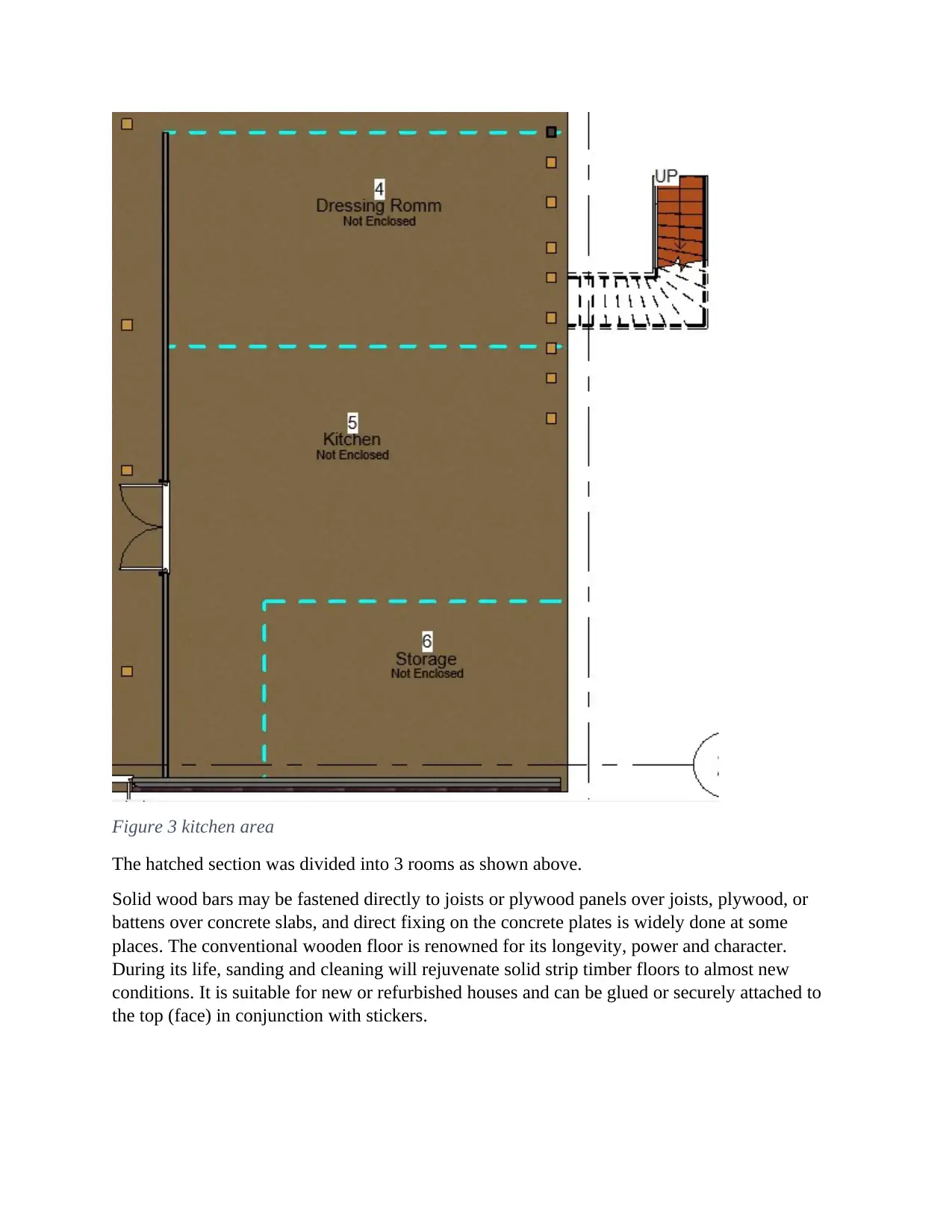
Figure 3 kitchen area
The hatched section was divided into 3 rooms as shown above.
Solid wood bars may be fastened directly to joists or plywood panels over joists, plywood, or
battens over concrete slabs, and direct fixing on the concrete plates is widely done at some
places. The conventional wooden floor is renowned for its longevity, power and character.
During its life, sanding and cleaning will rejuvenate solid strip timber floors to almost new
conditions. It is suitable for new or refurbished houses and can be glued or securely attached to
the top (face) in conjunction with stickers.
The hatched section was divided into 3 rooms as shown above.
Solid wood bars may be fastened directly to joists or plywood panels over joists, plywood, or
battens over concrete slabs, and direct fixing on the concrete plates is widely done at some
places. The conventional wooden floor is renowned for its longevity, power and character.
During its life, sanding and cleaning will rejuvenate solid strip timber floors to almost new
conditions. It is suitable for new or refurbished houses and can be glued or securely attached to
the top (face) in conjunction with stickers.
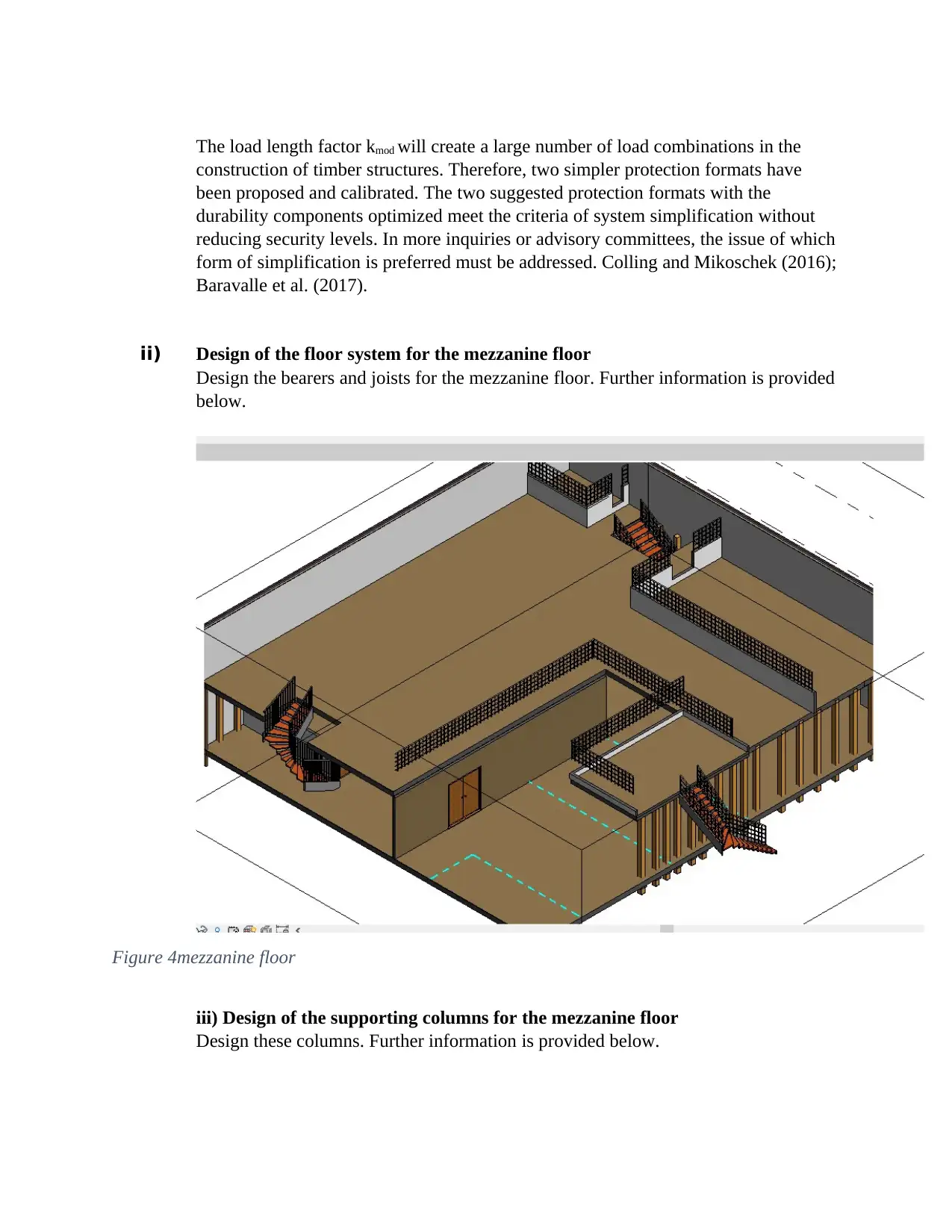
The load length factor kmod will create a large number of load combinations in the
construction of timber structures. Therefore, two simpler protection formats have
been proposed and calibrated. The two suggested protection formats with the
durability components optimized meet the criteria of system simplification without
reducing security levels. In more inquiries or advisory committees, the issue of which
form of simplification is preferred must be addressed. Colling and Mikoschek (2016);
Baravalle et al. (2017).
ii) Design of the floor system for the mezzanine floor
Design the bearers and joists for the mezzanine floor. Further information is provided
below.
Figure 4mezzanine floor
iii) Design of the supporting columns for the mezzanine floor
Design these columns. Further information is provided below.
construction of timber structures. Therefore, two simpler protection formats have
been proposed and calibrated. The two suggested protection formats with the
durability components optimized meet the criteria of system simplification without
reducing security levels. In more inquiries or advisory committees, the issue of which
form of simplification is preferred must be addressed. Colling and Mikoschek (2016);
Baravalle et al. (2017).
ii) Design of the floor system for the mezzanine floor
Design the bearers and joists for the mezzanine floor. Further information is provided
below.
Figure 4mezzanine floor
iii) Design of the supporting columns for the mezzanine floor
Design these columns. Further information is provided below.
⊘ This is a preview!⊘
Do you want full access?
Subscribe today to unlock all pages.

Trusted by 1+ million students worldwide
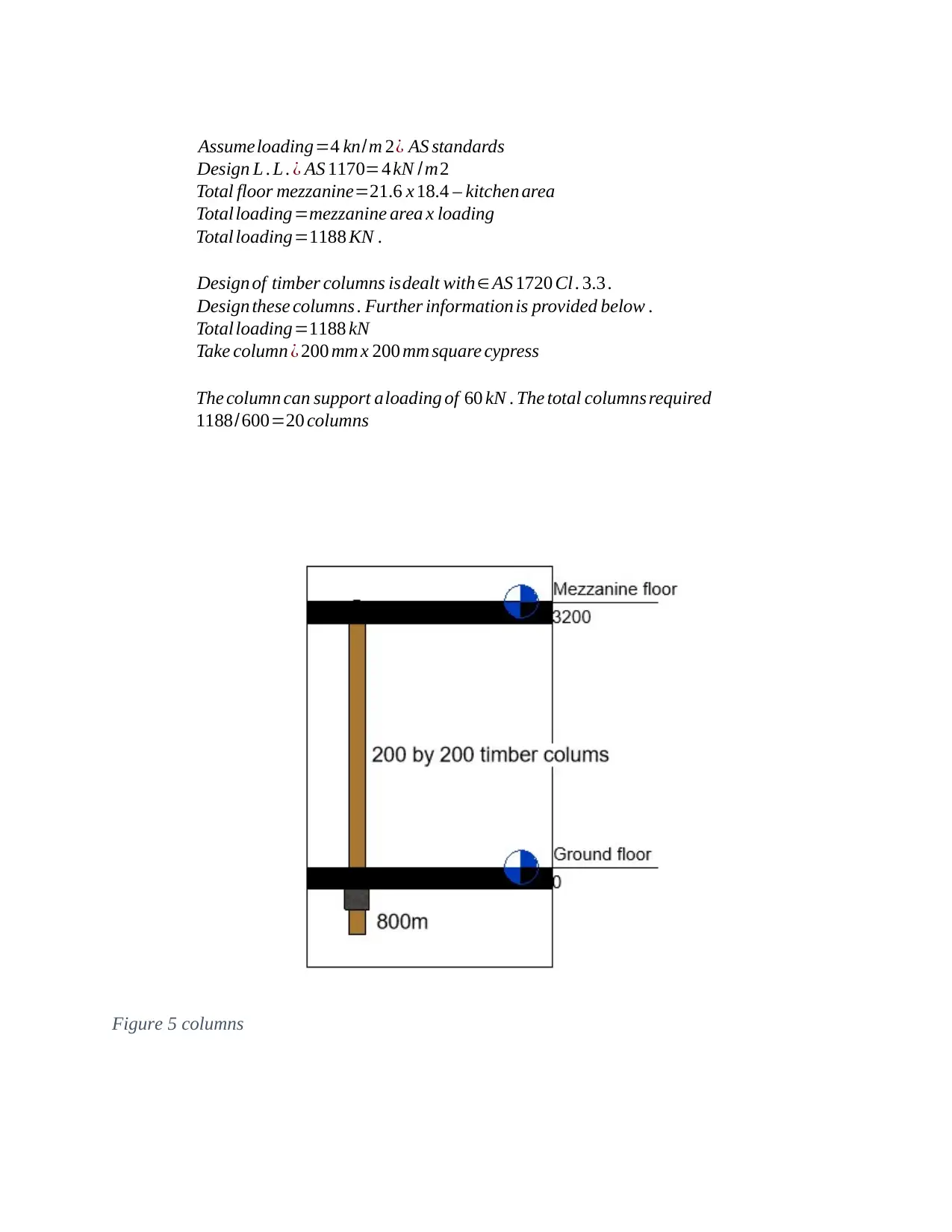
Assumeloading=4 kn/m 2¿ AS standards
Design L . L . ¿ AS 1170=4 kN /m2
Total floor mezzanine=21.6 x 18.4 – kitchen area
Totalloading=mezzanine area x loading
Total loading=1188 KN .
Design of timber columns isdealt with∈ AS 1720 Cl . 3.3 .
Design these columns . Further information is provided below .
Total loading=1188 kN
Take column ¿ 200 mm x 200 mm square cypress
The column can support aloading of 60 kN . The total columns required
1188/600=20 columns
Figure 5 columns
Design L . L . ¿ AS 1170=4 kN /m2
Total floor mezzanine=21.6 x 18.4 – kitchen area
Totalloading=mezzanine area x loading
Total loading=1188 KN .
Design of timber columns isdealt with∈ AS 1720 Cl . 3.3 .
Design these columns . Further information is provided below .
Total loading=1188 kN
Take column ¿ 200 mm x 200 mm square cypress
The column can support aloading of 60 kN . The total columns required
1188/600=20 columns
Figure 5 columns
Paraphrase This Document
Need a fresh take? Get an instant paraphrase of this document with our AI Paraphraser
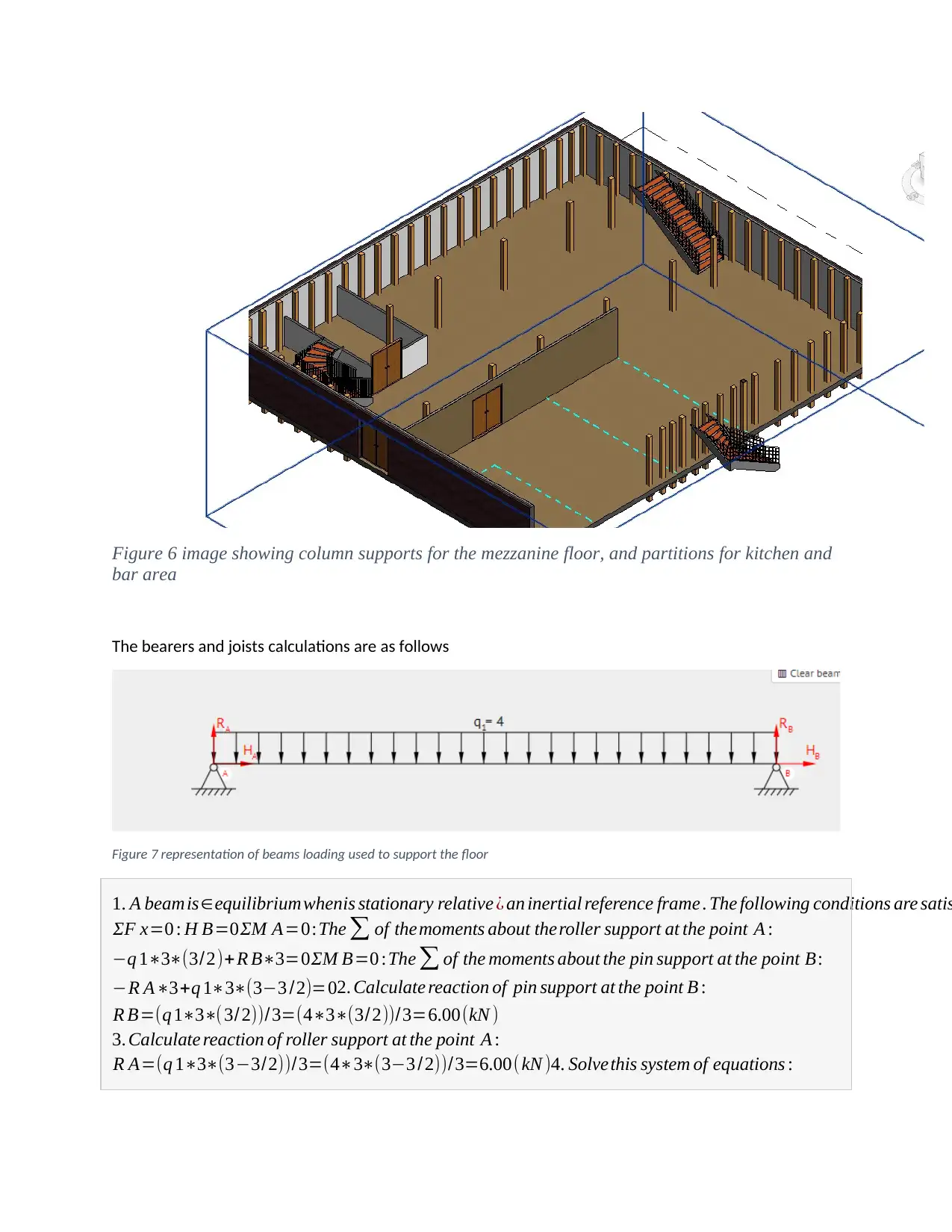
Figure 6 image showing column supports for the mezzanine floor, and partitions for kitchen and
bar area
The bearers and joists calculations are as follows
Figure 7 representation of beams loading used to support the floor
1. A beamis∈equilibrium whenis stationary relative ¿ an inertial reference frame . The following conditions are satis
ΣF x=0 : H B=0ΣM A=0:The ∑ of themoments about theroller support at the point A :
−q 1∗3∗(3/2)+R B∗3=0 ΣM B=0 :The ∑ of the moments about the pin support at the point B:
−R A∗3+q 1∗3∗(3−3 /2)=02. Calculate reaction of pin support at the point B :
R B=(q 1∗3∗(3/ 2))/ 3=(4∗3∗(3/2))/3=6.00(kN )
3. Calculate reaction of roller support at the point A :
R A=(q 1∗3∗(3−3/2))/3=(4∗3∗(3−3 /2))/3=6.00( kN )4. Solvethis system of equations :
bar area
The bearers and joists calculations are as follows
Figure 7 representation of beams loading used to support the floor
1. A beamis∈equilibrium whenis stationary relative ¿ an inertial reference frame . The following conditions are satis
ΣF x=0 : H B=0ΣM A=0:The ∑ of themoments about theroller support at the point A :
−q 1∗3∗(3/2)+R B∗3=0 ΣM B=0 :The ∑ of the moments about the pin support at the point B:
−R A∗3+q 1∗3∗(3−3 /2)=02. Calculate reaction of pin support at the point B :
R B=(q 1∗3∗(3/ 2))/ 3=(4∗3∗(3/2))/3=6.00(kN )
3. Calculate reaction of roller support at the point A :
R A=(q 1∗3∗(3−3/2))/3=(4∗3∗(3−3 /2))/3=6.00( kN )4. Solvethis system of equations :
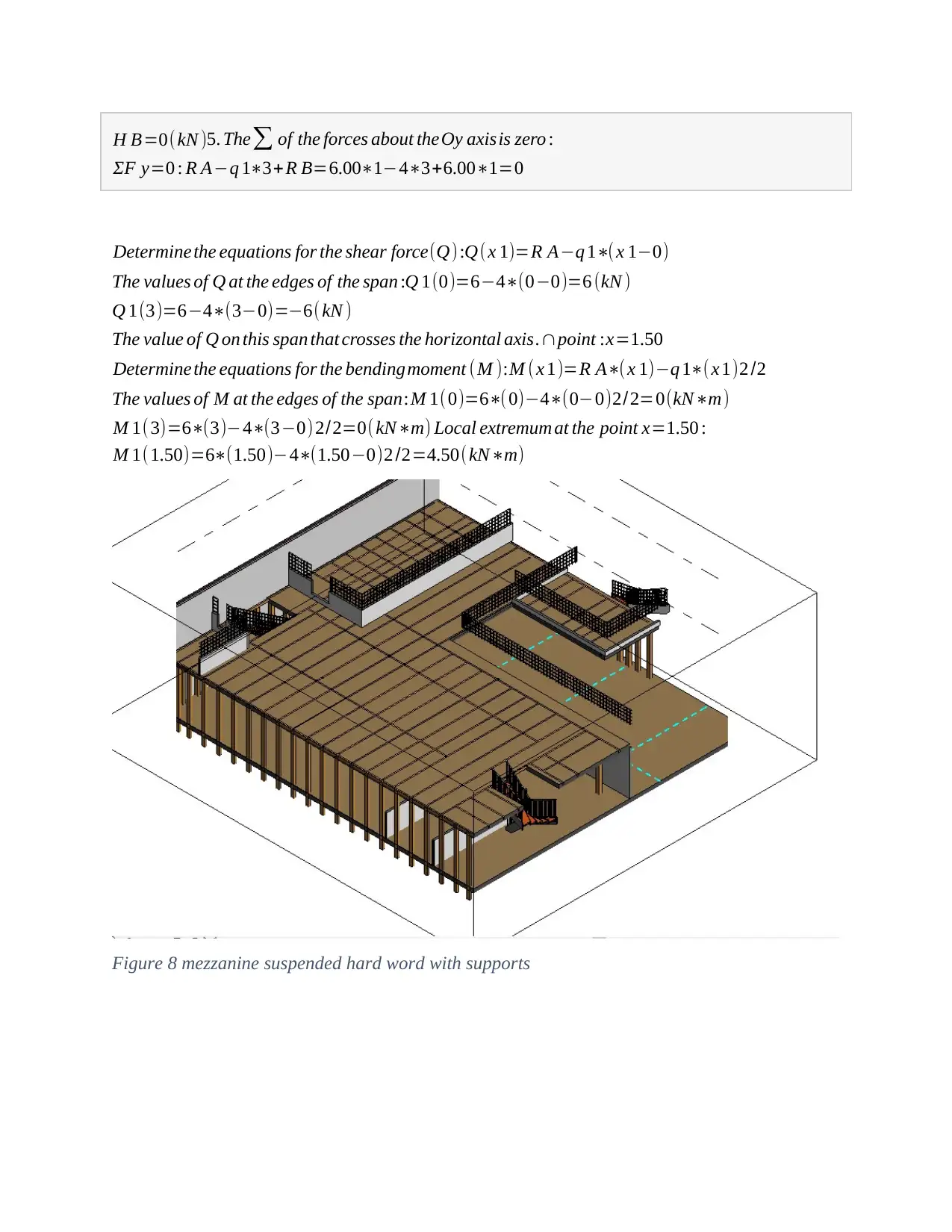
H B=0( kN )5. The∑ of the forces about theOy axisis zero :
ΣF y=0 : R A−q 1∗3+ R B=6.00∗1−4∗3+6.00∗1=0
Determine the equations for the shear force(Q) :Q(x 1)=R A−q 1∗( x 1−0)
The values of Q at the edges of the span :Q 1(0)=6−4∗(0−0)=6 (kN )
Q 1(3)=6−4∗(3−0)=−6( kN )
The value of Q on this span that crosses the horizontal axis.∩point : x=1.50
Determine the equations for the bendingmoment (M ):M ( x 1)=R A∗(x 1)−q 1∗(x 1)2 /2
The values of M at the edges of the span:M 1(0)=6∗(0)−4∗(0−0)2/2=0(kN∗m)
M 1( 3)=6∗(3)−4∗(3−0) 2/2=0( kN∗m) Local extremum at the point x=1.50 :
M 1(1.50)=6∗(1.50)−4∗(1.50−0)2 /2=4.50( kN∗m)
Figure 8 mezzanine suspended hard word with supports
ΣF y=0 : R A−q 1∗3+ R B=6.00∗1−4∗3+6.00∗1=0
Determine the equations for the shear force(Q) :Q(x 1)=R A−q 1∗( x 1−0)
The values of Q at the edges of the span :Q 1(0)=6−4∗(0−0)=6 (kN )
Q 1(3)=6−4∗(3−0)=−6( kN )
The value of Q on this span that crosses the horizontal axis.∩point : x=1.50
Determine the equations for the bendingmoment (M ):M ( x 1)=R A∗(x 1)−q 1∗(x 1)2 /2
The values of M at the edges of the span:M 1(0)=6∗(0)−4∗(0−0)2/2=0(kN∗m)
M 1( 3)=6∗(3)−4∗(3−0) 2/2=0( kN∗m) Local extremum at the point x=1.50 :
M 1(1.50)=6∗(1.50)−4∗(1.50−0)2 /2=4.50( kN∗m)
Figure 8 mezzanine suspended hard word with supports
⊘ This is a preview!⊘
Do you want full access?
Subscribe today to unlock all pages.

Trusted by 1+ million students worldwide
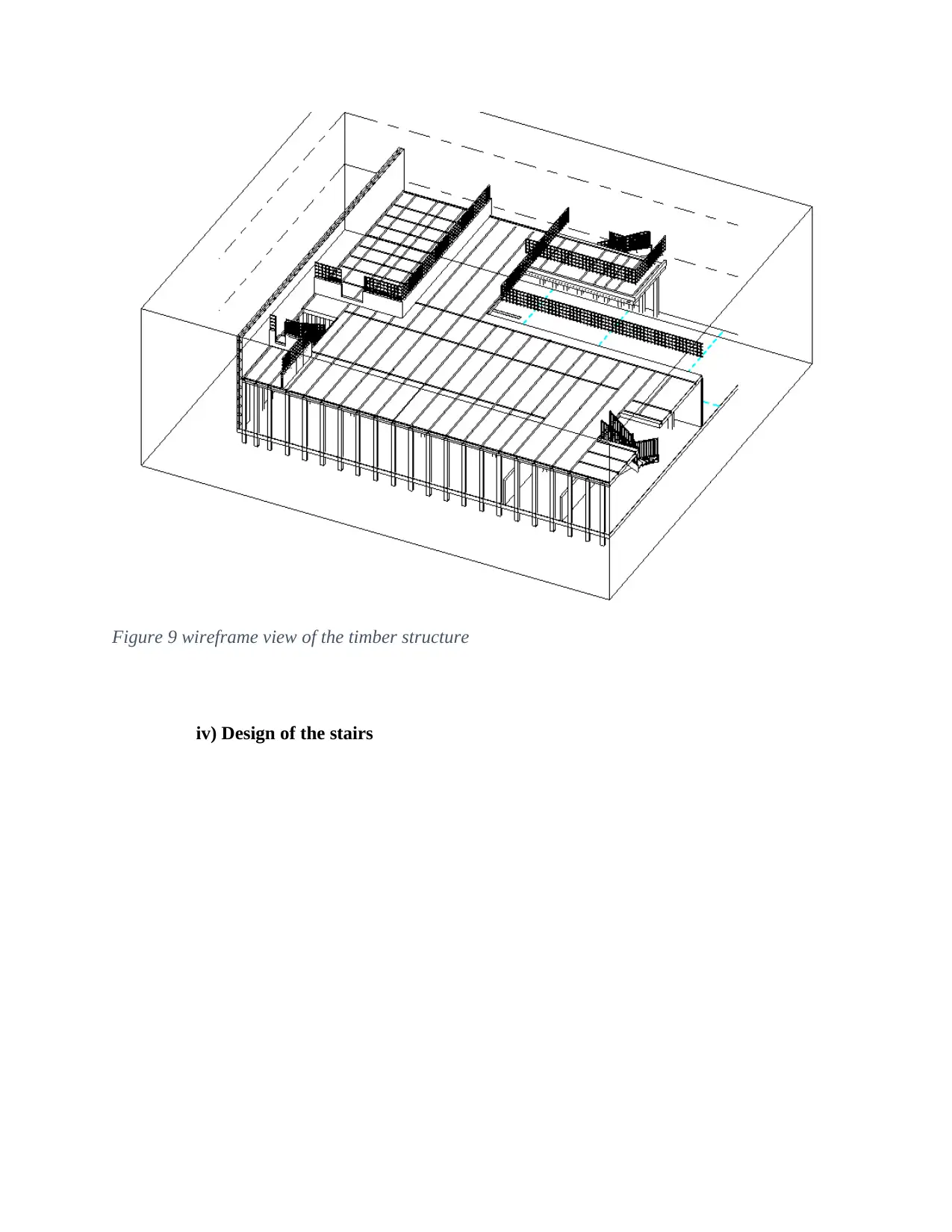
Figure 9 wireframe view of the timber structure
iv) Design of the stairs
iv) Design of the stairs
Paraphrase This Document
Need a fresh take? Get an instant paraphrase of this document with our AI Paraphraser
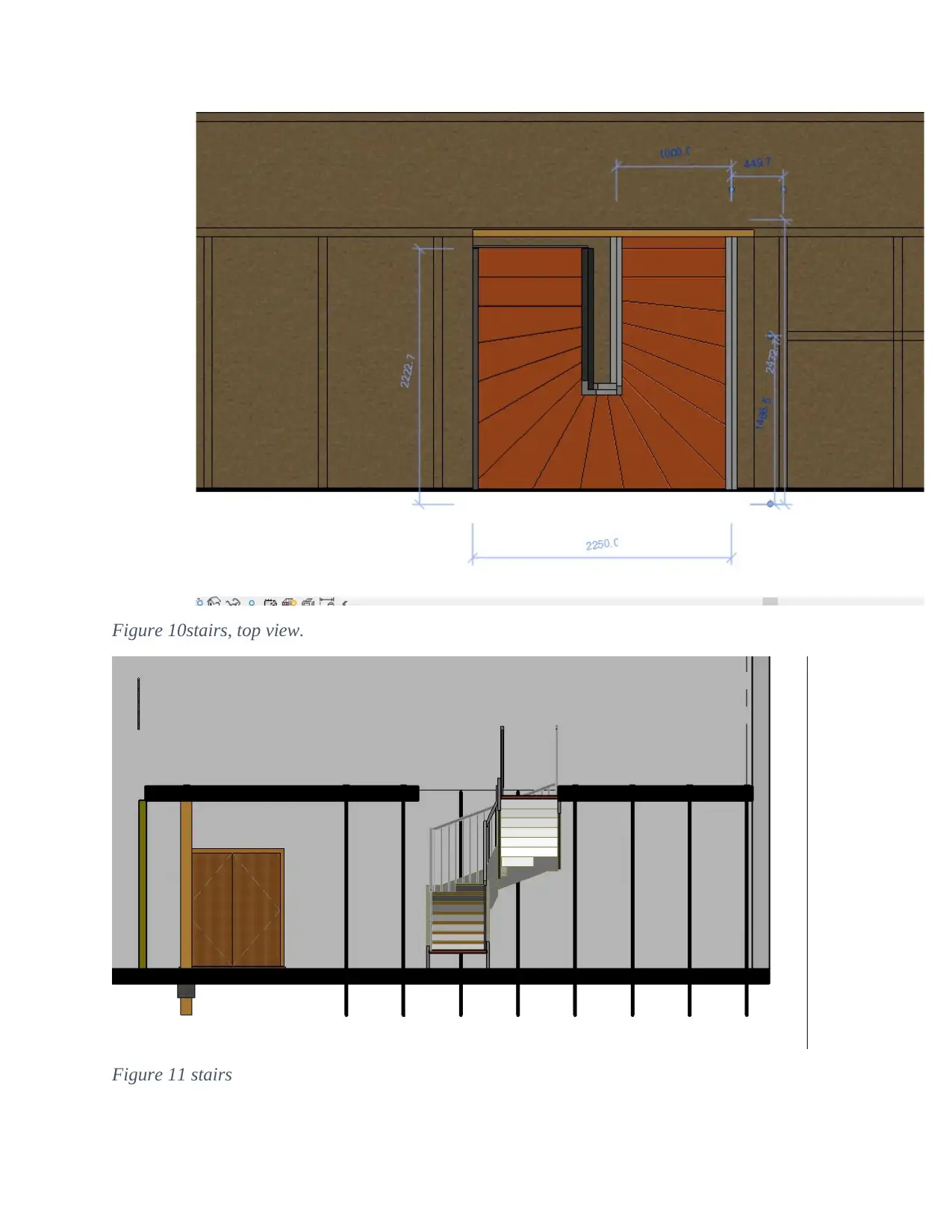
Figure 10stairs, top view.
Figure 11 stairs
Figure 11 stairs
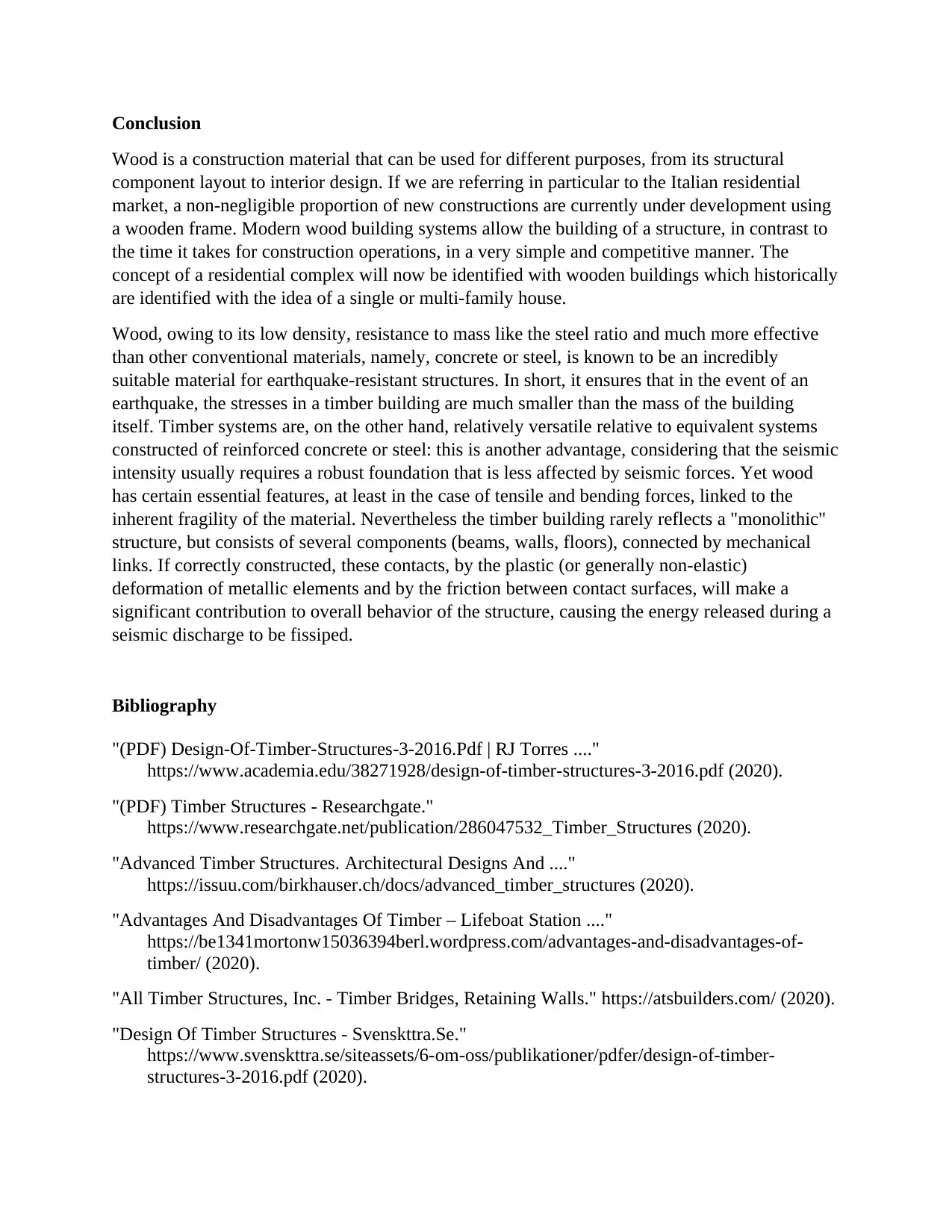
Conclusion
Wood is a construction material that can be used for different purposes, from its structural
component layout to interior design. If we are referring in particular to the Italian residential
market, a non-negligible proportion of new constructions are currently under development using
a wooden frame. Modern wood building systems allow the building of a structure, in contrast to
the time it takes for construction operations, in a very simple and competitive manner. The
concept of a residential complex will now be identified with wooden buildings which historically
are identified with the idea of a single or multi-family house.
Wood, owing to its low density, resistance to mass like the steel ratio and much more effective
than other conventional materials, namely, concrete or steel, is known to be an incredibly
suitable material for earthquake-resistant structures. In short, it ensures that in the event of an
earthquake, the stresses in a timber building are much smaller than the mass of the building
itself. Timber systems are, on the other hand, relatively versatile relative to equivalent systems
constructed of reinforced concrete or steel: this is another advantage, considering that the seismic
intensity usually requires a robust foundation that is less affected by seismic forces. Yet wood
has certain essential features, at least in the case of tensile and bending forces, linked to the
inherent fragility of the material. Nevertheless the timber building rarely reflects a "monolithic"
structure, but consists of several components (beams, walls, floors), connected by mechanical
links. If correctly constructed, these contacts, by the plastic (or generally non-elastic)
deformation of metallic elements and by the friction between contact surfaces, will make a
significant contribution to overall behavior of the structure, causing the energy released during a
seismic discharge to be fissiped.
Bibliography
"(PDF) Design-Of-Timber-Structures-3-2016.Pdf | RJ Torres ...."
https://www.academia.edu/38271928/design-of-timber-structures-3-2016.pdf (2020).
"(PDF) Timber Structures - Researchgate."
https://www.researchgate.net/publication/286047532_Timber_Structures (2020).
"Advanced Timber Structures. Architectural Designs And ...."
https://issuu.com/birkhauser.ch/docs/advanced_timber_structures (2020).
"Advantages And Disadvantages Of Timber – Lifeboat Station ...."
https://be1341mortonw15036394berl.wordpress.com/advantages-and-disadvantages-of-
timber/ (2020).
"All Timber Structures, Inc. - Timber Bridges, Retaining Walls." https://atsbuilders.com/ (2020).
"Design Of Timber Structures - Svenskttra.Se."
https://www.svenskttra.se/siteassets/6-om-oss/publikationer/pdfer/design-of-timber-
structures-3-2016.pdf (2020).
Wood is a construction material that can be used for different purposes, from its structural
component layout to interior design. If we are referring in particular to the Italian residential
market, a non-negligible proportion of new constructions are currently under development using
a wooden frame. Modern wood building systems allow the building of a structure, in contrast to
the time it takes for construction operations, in a very simple and competitive manner. The
concept of a residential complex will now be identified with wooden buildings which historically
are identified with the idea of a single or multi-family house.
Wood, owing to its low density, resistance to mass like the steel ratio and much more effective
than other conventional materials, namely, concrete or steel, is known to be an incredibly
suitable material for earthquake-resistant structures. In short, it ensures that in the event of an
earthquake, the stresses in a timber building are much smaller than the mass of the building
itself. Timber systems are, on the other hand, relatively versatile relative to equivalent systems
constructed of reinforced concrete or steel: this is another advantage, considering that the seismic
intensity usually requires a robust foundation that is less affected by seismic forces. Yet wood
has certain essential features, at least in the case of tensile and bending forces, linked to the
inherent fragility of the material. Nevertheless the timber building rarely reflects a "monolithic"
structure, but consists of several components (beams, walls, floors), connected by mechanical
links. If correctly constructed, these contacts, by the plastic (or generally non-elastic)
deformation of metallic elements and by the friction between contact surfaces, will make a
significant contribution to overall behavior of the structure, causing the energy released during a
seismic discharge to be fissiped.
Bibliography
"(PDF) Design-Of-Timber-Structures-3-2016.Pdf | RJ Torres ...."
https://www.academia.edu/38271928/design-of-timber-structures-3-2016.pdf (2020).
"(PDF) Timber Structures - Researchgate."
https://www.researchgate.net/publication/286047532_Timber_Structures (2020).
"Advanced Timber Structures. Architectural Designs And ...."
https://issuu.com/birkhauser.ch/docs/advanced_timber_structures (2020).
"Advantages And Disadvantages Of Timber – Lifeboat Station ...."
https://be1341mortonw15036394berl.wordpress.com/advantages-and-disadvantages-of-
timber/ (2020).
"All Timber Structures, Inc. - Timber Bridges, Retaining Walls." https://atsbuilders.com/ (2020).
"Design Of Timber Structures - Svenskttra.Se."
https://www.svenskttra.se/siteassets/6-om-oss/publikationer/pdfer/design-of-timber-
structures-3-2016.pdf (2020).
⊘ This is a preview!⊘
Do you want full access?
Subscribe today to unlock all pages.

Trusted by 1+ million students worldwide
1 out of 13
Your All-in-One AI-Powered Toolkit for Academic Success.
+13062052269
info@desklib.com
Available 24*7 on WhatsApp / Email
![[object Object]](/_next/static/media/star-bottom.7253800d.svg)
Unlock your academic potential
Copyright © 2020–2025 A2Z Services. All Rights Reserved. Developed and managed by ZUCOL.